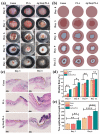Electroactive nanofibrous membrane with temperature monitoring for wound healing
- PMID: 37179989
- PMCID: PMC10170354
- DOI: 10.1039/d3ra01665j
Electroactive nanofibrous membrane with temperature monitoring for wound healing
Abstract
Developing functional dressings for promoting cellular activities and monitoring the healing progress is receiving increasingly widespread attention. In this study, Ag/Zn electrodes were deposited on the surface of a polylactic acid (PLA) nanofibrous membrane which can mimic the extracellular matrix. When wetted by wound exudate, the Ag/Zn electrodes could generate an electric stimulation (ES), promoting the migration of fibroblasts that heal wounds. Moreover, the Ag/Zn@PLA dressing showed excellent antibacterial activity against E. coli (95%) and S. aureus (97%). The study found that the electrostatic (ES) effect and the release of metal ions mainly contribute to the wound healing properties of Ag/Zn@PLA. In vivo mouse models demonstrated that Ag/Zn@PLA could promote wound healing by improving re-epithelialization, collagen deposition, and neovascularization. Additionally, the integrated sensor within the Ag/Zn@PLA dressing can monitor the wound site's temperature in real-time, providing timely information on wound inflammatory reactions. Overall, this work suggests that combining electroactive therapy and wound temperature monitoring may provide a new strategy for designing functional wound dressings.
This journal is © The Royal Society of Chemistry.
Conflict of interest statement
There are no conflicts to declare.
Figures









Similar articles
-
Cotton fiber-based dressings with wireless electrical stimulation and antibacterial activity for wound repair.Int J Biol Macromol. 2024 Jan;256(Pt 2):128496. doi: 10.1016/j.ijbiomac.2023.128496. Epub 2023 Nov 29. Int J Biol Macromol. 2024. PMID: 38035956
-
Novel PLA/ZnO Nanofibrous Nanocomposite Loaded with Tranexamic Acid as an Effective Wound Dressing: In Vitro and In Vivo Assessment.Iran J Biotechnol. 2021 Jul 1;19(3):e2737. doi: 10.30498/ijb.2021.220458.2737. eCollection 2021 Jul. Iran J Biotechnol. 2021. PMID: 34825013 Free PMC article.
-
Bromelain- and Silver Nanoparticle-Loaded Polycaprolactone/Chitosan Nanofibrous Dressings for Skin Wound Healing.Gels. 2023 Aug 19;9(8):672. doi: 10.3390/gels9080672. Gels. 2023. PMID: 37623127 Free PMC article.
-
Antibacterial biohybrid nanofibers for wound dressings.Acta Biomater. 2020 Apr 15;107:25-49. doi: 10.1016/j.actbio.2020.02.022. Epub 2020 Feb 19. Acta Biomater. 2020. PMID: 32084600 Review.
-
Electrospun Nanofibers/Nanofibrous Scaffolds Loaded with Silver Nanoparticles as Effective Antibacterial Wound Dressing Materials.Pharmaceutics. 2021 Jun 26;13(7):964. doi: 10.3390/pharmaceutics13070964. Pharmaceutics. 2021. PMID: 34206857 Free PMC article. Review.
Cited by
-
Smart Dressings and Their Applications in Chronic Wound Management.Cell Biochem Biophys. 2024 Sep;82(3):1965-1977. doi: 10.1007/s12013-024-01402-w. Epub 2024 Jul 5. Cell Biochem Biophys. 2024. PMID: 38969950 Review.
-
Electroactive Electrospun Nanofibrous Scaffolds: Innovative Approaches for Improved Skin Wound Healing.Adv Sci (Weinh). 2025 May;12(18):e2416267. doi: 10.1002/advs.202416267. Epub 2025 Apr 7. Adv Sci (Weinh). 2025. PMID: 40190057 Free PMC article. Review.
References
-
- Yang Y. Du Y. Zhang J. Zhang H. Guo B. Adv. Fiber Mater. 2022;4:1027–1057.
-
- Wang C. Liang Y. Huang Y. Li M. Guo B. J. Mater. Sci. Technol. 2022;121:207–219.
-
- Wu K. Yang Q. Zhang L. Xu P. Wu X. Yang H. Zhou H. Lin X. Yang L. J. Mater. Sci. Technol. 2023;133:123–134.
-
- Yu L. Zhang H. Xiao L. Fan J. Li T. ACS Appl. Mater. Interfaces. 2022;14:21814–21821. - PubMed
-
- Liang J. Zeng H. Qiao L. Jiang H. Ye Q. Wang Z. Liu B. Fan Z. ACS Appl. Mater. Interfaces. 2022;14:30507–30522. - PubMed
LinkOut - more resources
Full Text Sources

